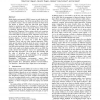Free Online Productivity Tools
i2Speak
i2Symbol
i2OCR
iTex2Img
iWeb2Print
iWeb2Shot
i2Type
iPdf2Split
iPdf2Merge
i2Bopomofo
i2Arabic
i2Style
i2Image
i2PDF
iLatex2Rtf
Sci2ools
GRAPHICSINTERFACE
2011
2011
Ubiquitous cursor: a comparison of direct and indirect pointing feedback in multi-display environments
Multi-display environments (MDEs) connect several displays into a single digital workspace. One of the main problems to be solved in an MDE’s design is how to enable movement of objects from one display to another. When the real-world space between displays is modeled as part of the workspace (i.e., Mouse Ether), it becomes difficult for users to keep track of their cursors during a transition between displays. To address this problem, we developed the Ubiquitous Cursor system, which uses a projector and a hemispherical mirror to completely cover the interior of a room with usable low-resolution pixels. Ubiquitous Cursor allows us to provide direct feedback about the location of the cursor between displays. To assess the effectiveness of this directfeedback approach, we carried out a study that compared Ubiquitous Cursor with two other standard approaches: Halos, which provide indirect feedback about the cursor’s location; and Stitching, which warps the cursor between displays, si...
| Added | 28 Aug 2011 |
| Updated | 28 Aug 2011 |
| Type | Journal |
| Year | 2011 |
| Where | GRAPHICSINTERFACE |
| Authors | Robert Xiao, Miguel A. Nacenta, Regan L. Mandryk, Andy Cockburn, Carl Gutwin |
Comments (0)

